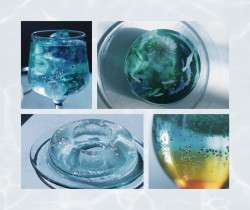
July 2, 2009
Kitchen Crusaders
From high-end Japanese cuisine to crowd-pleasing Italian, these four chefs have added a dash of excitement to Tokyo's restaurant scene
By Metropolis
Originally published on metropolis.co.jp on July 2009

Photos by cedric leherle
Great cooking is all about contrasts—sour and sweet, crunchy and soft, spicy and not. But here’s a new contrast for you: the 30cm space of a saucepan and the boundless creativity of a talented chef. This contrast creates a delicious tension, a dynamic of change and discovery that moves you from one place to another.
And if you know anything about our city, you know that Tokyo is blessed with an abundance of culinary talent. Here are four outstanding chefs who embody that dynamic contrast, chefs ready to take you on a journey.

Keitaro Baba
Maybe it’s the 50km tours he takes on his Italian bicycle or his years as a ski instructor, but with his athletic build and tight black T-shirt, Keitaro Baba, 38, looks like an Olympic gymnast moving gracefully through his wide, open kitchen.
After graduating from Tsuji cooking school in 1990, Baba spent a few years skiing in the winters and working in restaurants during the summers.
He then heard about the good life in Italy from a friend and decided to journey there himself.
“I didn’t speak a word of Italian,” he says. “But I set off for Firenze and asked at over 20 restaurants for a job until one place finally accepted me.”
After moving on to Siena, he worked in three different restaurants. At the last place, the owner had an interest in racehorses, particularly ones from Sardinia, and—luckily for Tokyo diners—asked Baba to go with him to the island.
The budding chef took a job in a restaurant in Santa Teresa di Gallura, whose azure and aquamarine coves are rimmed with white sand beaches. “I loved the resort ambiance of the place first, and discovered the delicious Sardinian food second,” he says.
After two years in Sardinia, Baba was drawn back to Tokyo. He worked in a succession of Italian restaurants, but eventually decided to open his own, one that reminded him of the resort area of Santa Theresa.
“I wanted to create that type of relaxed atmosphere, a slow-paced spot where you could have a decent espresso at the counter for only ¥100, or a good glass of wine,” he explains. “Of course, great food too. But, first of all, I want customers to enjoy themselves, whether they are friends or lovers. To make a place to talk, to have fun, having great wine, and everything at an inexpensive price.”
He pauses. “But more than just comfortable,” he adds, “I wanted a place with music, with the sounds of cutlery on plates, the buzz of conversation. I wanted to create a lively Italian atmosphere.”
Baba makes food that’s cheap and simple. And the tastes at Tharros are straightforward, hearty and delicious, from the daily tapas selections (like ratatouille and marinated seafood) to the housemade pastas (gnocchetti with Sardinian pecorino sardo and black pepper; shepherd’s-style lasagna) and the seafood dishes (carpaccio of bluefin tuna and mozzeralla with tuna botargo; fusilli with tomato-stewed tripe of tuna).
“The most important thing about my menu is that if you close your eyes, you still know what you’re tasting,” he says. “We don’t use much butter or cream that might mask other flavors. For example, the trevise risotto. When you eat it, the taste of trevise [a kind of Italian lettuce] really shines through, and you know right away what it is. That’s the kind of food I want to make.”
The Sardinian wines featured at Tharros are justly famous, and good value too. “You can’t get most of these bottles in Tokyo’s liquor shops,” he says. “I source them from friends and suppliers in different places.”
Baba is a practical man, intent on doing good work. He’s not really stressed by the grueling daily schedule.
“Yeah, it’s tough working from early morning to late at night,” he admits. “And it’s difficult sometimes to keep the staff motivated. But I love cooking. I like making things.”

Masayo Funakoshi
When she was 9 or 10 years old, Masayo Funakoshi, 33, executive chef at one of Tokyo’s most exciting new restaurants, remembers going boating with a bunch of friends on Shinobazu Pond in Ueno.
“There were ten of us in three or four boats,” she recalls. “At that time, I really loved cooking pancakes, so on that day I made a huge stack of pancakes and layered them with butter. But we were on boats and I couldn’t reach my friends,” she laughs. “So we had to toss the pancakes like frisbees to each other. We had such fun.”
Though she’s always loved cooking, Funakoshi didn’t set out to be a chef; she wanted to be an artist. After attending a fine arts high school in Tokyo, she enrolled in the Pratt Institute in New York City. But after a couple of years, she had a change of heart.
“I loved making installation art and sculpture, but it took such a long time to complete a piece,” she explains. “And it didn’t quite fit my personality. I wanted to create things more quickly, and realized that cooking would be perfect for me.”
So she quit art school and enrolled in New York’s Institute of Culinary Education, because it had the shortest course. She then worked for five years in three of New York City’s most famous restaurants: at Blue Hill with chef Michael Anthony, Union Pacific with Rocco DiSpirito, and WD-50 with Wylie Dufresne. After a stint in Paris at the Michelin-starred L’Astrance, another boat trip literally took her in a new direction. She journeyed through Indonesia and Papua New Guinea as a chef on a private cruise ship. That year-and-a-half excursion intensified her love of spices and eclectic ingredients.
“I went shopping in local markets almost every day,” she says. “They had a very limited choice of things, only coconuts, green tomatoes, and tiny, tiny lettuces, but also great things like stone crabs, or coconut crabs.”
Eventually Funakoshi felt the need to get back to her roots, to Japan, so she worked for a year in a Japanese restaurant in Ebisu, where some lucky investors tapped into her talent. Cujorl, which opened less than a year ago, has a very hip, casual New York vibe.
“I don’t know what to call this type of food, because it’s pretty original, but it expresses where I’ve been and what I’ve been through,” she explains. “The basic concept is ‘American creative’, which uses French cooking techniques, but with ingredients from anywhere. It really frees my mind.
“Let’s call it ‘Tokyo creative’,” she says with a laugh.
Cujorl’s menu is eclectic, reflecting the chef’s artistic sense of color, contrast and structure, plus her love of smells, spices, and the exotic ingredients she’s found along her journey. Dishes include spring bonito and papaya-melon carpaccio with lime and Japanese pepper vinaigrette; razor clams and garlic risotto with five-color baked tomatoes; and roasted smoked pigeon with espresso sauce and “Moroccan atmosphere.”
Of course, Funakoshi wants her customers to enjoy their food, but she also aims to entertain them.
“I want their experience to be different than eating at home. I want to give them something special,” she says. Her “Mushroom Cappuccino w/Milk & Sugar?” exemplifies this approach.
“It’s so simple,” she explains. “We use four kinds of mushrooms for the broth, which I serve with a milk foam and sugar—but it’s not sugar. It’s lumps of meringue flavored with porcini powder. They look just like dark sugar.”
She’s right—this superb first course is one of Cujorl’s most popular dishes.
“We get a lot of good reactions from non-Japanese customers, but my biggest challenge is that Japanese people are not used to this kind of food,” she explains. “They ask, ‘Is this French? Is this Italian? Is this American?’
“Like, for me, it doesn’t matter,” she says with a shrug. “It’s my food.’

Lionel Beccat
“I have a story to tell with my food,” says Lionel Beccat, 33, executive chef of the Michelin two-star restaurant Cuisine[s] Michel Troisgros at the Hyatt Regency Tokyo in Shinjuku. “I want you to travel, to make you travel in the ‘mental terroir,’ a place that everyone has, his or her own.”
Born on the Mediterranean island of Corsica, Beccat grew up in Marseilles, in the south of France. As a child, he remembers his grandmother’s cooking, the aroma of fish and the smell of the sea.
Beccat has the soul of an artist. After high school he worked a series of jobs before deciding his canvas was the art of cooking. In 2002, he started his culinary career with Michel Troisgros, the third-generation chef of the renowned Roanne family, who pioneered a style of cuisine combining French, Japanese and Italian influences. Beccat works within Troisgros’ own original approach of “cuisine acidulée” which uses the fruity, palate-stimulating tastes of yuzu, sudachi, kumquat, apple, mango and other “acidic” flavors to complement the savory tastes of meat, fish, and vegetables.
“Cooking is an expression of yourself,” he explains, “and I use acidity in a slightly different way—to pinpoint tastes.”
Beccat’s current menu includes dishes such as small “Mezzaluna” ravioli with ricotta, wild fennel, ice-cold tomato and yuzu à la nage; clams and caviar with apple and basil jelly; smoked pigeon, raspberry and wasabi with rocket salad; melting “Agu” pork breast with Indonesian satay, green mango and Chinese cabbage; and lightly fried scampi with grapefruit and celery.
The chef describes this menu as a culinary journey through Japan and France, with some tastes from imaginary stopovers in Indonesia, Thailand, Lebanon, Spain and Italy. “As I don’t have the appropriate skills to tell you about these stopovers with words,” he writes on his restaurant’s blog, “I would like to invite you to discover them with your taste buds.”
On his own journeys, though, Beccat brings back more than just recipes or foodstuffs. He brings back emotions, and he wants his guests to be taken over by colors, shapes, scents, tastes, even desires.
“Cherries, for example, are so sexy,” he says with great energy. “I love working with them in summer. They are a sexual family—peaches, tomatoes, cherries. They are very sensual.” He’s now using both hands to gesture. “Their texture, their taste, their blood color—fantastic!”
Beccat imbues each dish with emotion, but one downside of working in his restaurant’s large kitchen is that he can’t hand his food directly to the customer. And though the service at Cuisine[s] is impeccable, the staff, he says, can be a little shy. “They are my link to the customer, and sometimes they don’t explain the food passionately enough.” He shrugs.
“Cooking is about giving and receiving love,” he continues, flashing a smile. “We chefs need to be loved. If a Michelin-starred chef says, ‘I don’t care about love,’ he’s lying.”

Mitsuo Yomeyama
When he was just 8 years old, Mitsuo Yoneyama knew he would be a cook. His father was a sushi chef and the shop was always busy.
“I watched my father work every day,” says the 42-year-old owner of Yoneyama in Yotsuya, “and I watched cooking shows on TV, especially an American chef cooking in front of guests.”
Yoneyama himself started off studying French cooking at a culinary school in Osaka, but later switched to Japanese food. In his early 20s, he worked his way around kitchens in Europe—Munich for a couple of years, then Siena, Italy, for a while. Arriving back in Tokyo, he continued to expand his repertoire.
“I worked in all kinds of places here: an izakaya, a yakitori shop, a delivery soba shop, a ramen shop,” he says. “I wanted to experience a variety of places—even a curry rice shop.”
Yoneyama opened his restaurant about four years ago on a quiet side street. His world is a counter that seats five, plus two small tables. He serves only two courses: ¥10,000 and ¥15,000, and every day he journeys to Tsukiji market on a mountain bike to gather the finest fish, meat and vegetables, which he carries back in a rucksack.
Yoneyama’s craft is rather like kaiseki, with its progression of small exquisite foods served in equally beautiful dishes, but the chef claims he only serves simple foods with simple tastes.
“I use the best ingredients and don’t want to change them too much, or change their shape,” he explains. “When you eat it, for example, sea bass tastes like sea bass, or eggplant tastes like eggplant.
“My inspiration comes from what I want to eat that day. I don’t sit down and write out menus, or make sketches. I just think about the day, like if it’s hot, I think, ‘I’d like to eat eggplant.’”
But Yoneyama’s cooking isn’t solely based on his own tastes; he also looks at the daily reservation sheet and thinks about the preferences of each visitor. “Most of my guests are repeat customers, and I remember, ‘Ah, he likes turtle, so I should buy some today.’
“I’m making one dish at a time,” he continues. “At a French restaurant, the chef can’t see the customer’s face. But I see everyone. And I see their faces when they eat something, and I’m satisfied.” He smiles. “I like happy faces. Like a child when they get a new toy, the customers’ faces light up.”
But taste is not the only important factor, he explains. Good food also depends on the touch of the bowl or plate in your fingers, on smell, on color, on arrangement, and on temperature. Moving food from the grill, or kitchen, to the counter changes it. If his restaurant had two floors, he wouldn’t be able to serve things properly.
Consider a dish of skewered barracuda fillet that Yoneyama slowly and carefully grilled over coals. When he turned to place the fish on its glazed stoneware plate, its sizzle and smell wafted across the counter. Later, when he served his ebi-dashi hiyakake somen, a sorbet-like slush of ice crystals briefly graced the surface of the richly flavored broth. Within a minute after serving, though, the ice had melted, changing the temperature, taste and texture of the dish.
“Food is alive,” he stresses. “I’ve got to give it to you directly, hand to hand. From my heart to your hand.”
Tharros
Tapas start at ¥1,200 for a choice of three; pasta from ¥1,600. Wine at the bar counter from ¥500. 1-5-2 Dogenzaka, Shibuya-ku. Tel: 03-5489-8989. Open Mon-Fri 11:30am-3pm and 6pm-midnight, Sat noon-3pm and 6pm-midnight, closed Sun. www.tharros.com
Cujorl
Course dinners ¥6,000. À la carte appetizers from ¥900, pasta from ¥1,400, main dishes from ¥2,500. 22-8 Sakuragaoka-cho, Shibuya-ku. Tel: 03-5784-5818. Open daily 11:30am-midnight. Nearest stn: Shibuya. www.to-vi.jp
Cuisine[s] Michel Troisgros
Lunch course from ¥7,900, dinner courses from ¥14,700.
1F Hyatt Regency Tokyo, 2-7-2 Nishi-Shinjuku, Shinjuku-ku. Tel : 03-3348-1234. Open Mon-Tue & Thu-Sun 11:30am-2pm & 6-9:30pm, closed Wed. Nearest stn: Shinjuku, west exit. www.cuisinesmicheltroisgros.com
Yoneyama
Dinner courses ¥10,000 and ¥15,000. 15 Araki-cho, Shinjuku-ku. Tel: 03-3341-3117. Open Mon-Sat 6-9:30pm, closed Sun. Nearest stn: Yotsuya-Sanchome.







